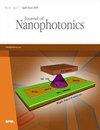具有双重光子特性的微小杂化改性有机硅-二氧化钛纳米复合材料:对增强内流信号传导的启示
IF 1.1
4区 物理与天体物理
Q4 NANOSCIENCE & NANOTECHNOLOGY
引用次数: 0
摘要
我们研究了具有潜在应用价值的微小二氧化钛纳米粒子(TiO2 NPs)的光谱特性,方法是激发多模式能量模式。因此,我们用带有荧光激光染料报告器的短改性有机硅烷修饰了 2 到 4 nm 大小的纳米颗粒。通过这种方式,纳米粒子表面覆盖了几纳米长的硅烷化间隔,并形成了一个额外的保护壳。未经改性的二氧化钛 NPs 由于尺寸减小而显示出较高的相互作用,通过 TEM 可以观察到均匀的纳米图案阵列。硅烷化的纳米粒子也具有更高的可分散性和更强的胶体分散性。众所周知,硅烷醇基团之间可以形成很强的极性和氢桥,但只需通过超声处理,聚集体就能很容易地重新分散。通过这种方式,在没有二氧化硅壳的情况下,就无法生成高有序的纳米图案。通过动态光散射,我记录到胶体分散体在水性溶剂存在下的尺寸为 2 至 3 纳米,而与十聚体形式相对应的更小的纳米聚集体尺寸为 30 纳米。在这种情况下,我强调了控制纳米表面和介质的相互作用和纳米图案的可能性。未标记的二氧化钛 NPs 在 298.0 纳米和 560.0 纳米处显示出强烈的吸收。此外,随着浓度的增加,修饰过的纳米粒子在 298.0 纳米波段的吸收带呈恒定的比例增长。此外,紫外波段还伴随着荧光团最大吸收波长从 553.0 纳米到 557.0 纳米的红移。这是因为以 537 nm 为中心的激光染料吸收与纳米平台的长波段吸收之间存在相互作用。然后,为了评估它们在激发态下的相互作用,我评估了游离荧光团和纳米平台上沉积荧光团的荧光寿命衰减(τ)。此外,我还评估了在流式细胞仪(IFC)中对修饰过的 TiO2 纳米平台的检测情况。通过这种方法,我观察到τ缩短,同时检测到的荧光事件计数增加。值得注意的是,在这些条件下,我没有观察到荧光报告物的降解。不过,在没有改性有机硅烷的情况下,我观察到了紫外线照射下快速光降解的潜在启示。因此,我设计并合成了一种稳定的改良型微小纳米发光体,有望用于纳米光子学、生物光子学和纳米医学应用。因此,我将从这一角度探讨开发具有多种功能和应用的多模式纳米平台。本文章由计算机程序翻译,如有差异,请以英文原文为准。
Tiny hybrid modified organosilane-titanium dioxide nanocomposites with dual photonic behavior: insights for enhanced in-flow signaling
We studied spectroscopical properties of tiny TiO2 nanoparticles (TiO2 NPs) with potential applications by the stimulation of multi-modal energy modes. Thus, nanoparticles of 2 to 4 nm sizes were modified with short modified organosilane with a fluorescent laser dye reporter. By this manner, it was covered with silanized spacer lengths of few nm with an additional protective shell. The non-modified TiO2 NPs showed high interactions between them due to their reduced sizes that afforded to homogeneous nano-patterned arrays observed by TEM. Silanized nanoparticles also afforded higher dispersible colloidal dispersion with strong interactions. As it is known, silanol groups could form strong polar and hydrogen bridges between them, but the aggregates could be easily re-dispersed just by sonication. By this manner, generation of a high-ordered nano-pattern was lost in the absence of silica shells. By dynamic light scattering, I recorded within colloidal dispersions sizes of 2 to 3 nm in presence of aqueous solvent and smaller nanoaggregates of 30 nm corresponding to decamer forms. In this context, I highlighted the possibility of managing interactions and nano-patterns controlling nano-surfaces and media. Non-labeled TiO2 NPs showed strong absorptions centered at 298.0 and 560.0 nm. Moreover, modified nanoparticles showed a constant and proportional increase of the 298.0 nm absorption band with the augmentation of the concentration. Moreover, the UV band was accompanied with a redshifted maximal absorption wavelength by the fluorophore incorporated from 553.0 to 557.0 nm. This fact was explained between an interaction between the absorption of the laser dye centered at 537 nm and the longer band by the nanoplatforms. Then, in order to evaluate their interactions in the excited state, I evaluated fluorescence lifetime decays (τ) of the free fluorophore and deposed on nanoplatforms. In addition, I evaluated the detection of the modified TiO2 nanoplatforms within in-flow cytometry (IFC). In this manner, I observed τ shortening accompanied with augmented counting of fluorescence events detected. It should be noted that in these conditions, I did not observe degradation of the fluorescent reporter. However, in absence of the modified organosilanes, I observed potential insights of fast photo-degradation under UV light irradiation. Therefore, I designed and synthesized a stable and improved tiny nano-emitter with potential use for nanophotonics, biophotonics, and nanomedicine applications. Thus, in this perspective, I discuss the development of multimodal nanoplatforms for varied functionalities and applications.
求助全文
通过发布文献求助,成功后即可免费获取论文全文。
去求助
来源期刊

Journal of Nanophotonics
工程技术-光学
CiteScore
2.60
自引率
6.70%
发文量
42
审稿时长
3 months
期刊介绍:
The Journal of Nanophotonics publishes peer-reviewed papers focusing on the fabrication and application of nanostructures that facilitate the generation, propagation, manipulation, and detection of light from the infrared to the ultraviolet regimes.
 求助内容:
求助内容: 应助结果提醒方式:
应助结果提醒方式:


